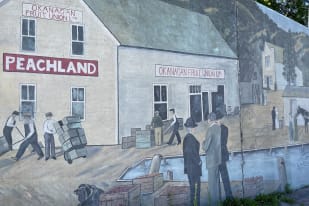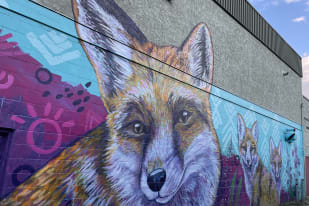The Early Days
A unique tourist destination with a rich history, Peachland's story begins 10,000 years ago when a massive glacier, up to 3,000 metres thick, shaped the Okanagan. This glacier sculpted the valley and created Okanagan Lake, leaving behind the scenic landscapes and mountain views we enjoy today.
The Syilx/Okanagan people were the first to call this place home, taking care of the land and practicing their culture despite colonial oppression. Their territory spans 69,000 square kilometres, extending into Washington State.
European Settlers and the Birth of Peachland
European settlers first travelled through this area in 1812. In 1884, Charles Lambly began ranching and growing crops here. Originally called Lambly’s Landing, the area saw its potential as a mining town. The first mine, Gladstone Mine, was initially owned by Gus Hewitt and later bought by J.M. Robinson. Robinson, captivated by the peaches grown at Lambly’s ranch, named the town Peachland in 1898.
With the decline of the mining industry, other industries like agriculture and logging took over. Today, Gorman’s mill in Westbank is the last sawmill standing. Peachland became a municipality in 1909, and you can still see historic buildings and monuments that tell the town's story.
Gathering Power
Trepanier Creek saw its first dam, a wooden structure, in 1909. It was replaced by a concrete dam in 1938, the remains of which can still be seen on the Stave Pipe Hiking Trail. This dam was a pivotal development, transforming the town's power supply.
After becoming a municipality in 1909, Peachland secured a provincial debenture to construct a power system, diverting dam water to a reservoir through a wooden pipeline. By 1916, the rise of electric irons led to power cuts on Washday Wednesday, and a 25-cent fee for iron users. The 1920s saw half-day power cuts to manage demand. Despite upgrades in the 1940s, funding shortages stalled progress. By 1947, locals voted overwhelmingly to sell the power system to the BC Power Commission, marking a significant transition in Peachland's power history.
Gathering Peaches
Logging and orcharding have long been intertwined in Peachland. Many residents worked as loggers in winter and orchardists in summer. Clearing Yellow Pine trees made way for fruit orchards and provided materials to build homes and packing boxes.
The Lambly brothers were among the first settlers, establishing Lambly Landing beside Trepanier Creek in 1887. Their efforts laid the groundwork for Peachland's development. By 1890, J.M. Robinson purchased adjacent land, forming the Peachland Townsite Company and officially naming the area.
Where Are the Peachland Peaches?
The winter of 1949-50 brought disaster to Peachland’s orchards. Temperatures plummeted to -40 degrees, freezing Okanagan Lake and killing the peach trees. While locals enjoyed ice skating on the frozen lake, the freeze devastated the fruit industry, leading to the closure of the first packing house built in 1905.
Gathering Timber
Logging was Peachland's first sustainable industry, with five mills operating until the early 1970s. The hills were originally covered in mature ponderosa pine and Douglas fir, along with other species like jack pine, cottonwood, birch, maple, and cedar.
Billy Miller was a renowned logger, famous for his innovative log chutes. His first chute, built in 1912 at Drought Hill, was a marvel of engineering, carrying logs swiftly down to the lake. Other chutes, like the one near Deep Creek, were equally impressive, with logs hurtling into the lake with spectacular splashes.
Logging was hazardous, with many workers suffering injuries. Charlie Pope lost both index fingers in separate sawmill accidents, showcasing the dangers faced by loggers daily.
Gathering Minerals
Peachland's mining history is filled with tales of gold, silver, and copper. J.M. Robinson started the Gladstone Mine in 1887 on Pincushion Mountain. Despite initial enthusiasm, many mines, like the Copper King Mine reclaimed by Bob Bechtel in 1944, faced challenges and were eventually abandoned.
Thomas Shorts
Captain Thomas D. Shorts began a ferry service on Okanagan Lake with his rowboat, the Ruth Shorts. His dedication led to the acquisition of the Mary Victoria Greenbow, a steamship that marked the transition from rowing to powered transport.
The introduction of steamships like the SS Sicamous and SS Okanagan transformed travel and trade, connecting Peachland to other communities. The opening of the Okanagan Lake Bridge in 1958 further boosted connectivity, making vehicle transportation more accessible.
Highway 97 and the Fur Brigade Trail
The Fur Brigade Trail of 1858, used by fur traders over a century ago, still bears traces of old irrigation flumes that transported water to orchards and farms, a demonstration of the ingenuity of early settlers. The newer Highway 97, completed in 1953, stretches 2081 kilometres from the US border to the Yukon. Its construction overcame significant obstacles, including the formidable rocky outcroppings known as "the bumps."
Exploring Historical Landmarks
Historic Mural
Completed in 1999, the historic mural was a project by the Peachland Rotary Club and the Peachland Community Arts Council. It is 45 metres long and begins at the town's entrance. Designed by four members of the arts council and painted by Robyn Lake, the mural features real residents and a dog. The Peachland Community Arts Council continues to maintain it.
The Baptist Church
Built in 1912, this church once held baptisms in the lake. The congregation moved in 1964, and the building has since served various roles, including as a municipal hall and a museum. The second floor houses a model of the Kettle Valley Railway.
Walters Packing House
Heritage Park was the original location of Walters Limited Packing House, which burned down in 1979. Today, the park features a gazebo and an accessible lakefront pier.
Ogopogo: Myth or Reality?
The legend of Ogopogo, or N’ha-a-itk, dates back thousands of years. This lake monster has been sighted numerous times and is part of the local folklore. While some dismiss it as myth, others believe in its existence, supported by numerous documented sightings and videos. Ogopogo remains a symbol of the area, celebrated by both indigenous and western cultures.
Conclusion
Peachland’s rich history and community spirit make it a fascinating place to explore. Each chapter, from gathering power to taming the wilderness, reveals a town that has always embraced its challenges and emerged stronger.





